Everyone enjoys a day at the beach, but for sea turtles safe beach access is a matter of life and death.
Sea turtles lay their eggs on the beach. Nesting is often the only time female sea turtles touch land.
It’s a time of peril: both females and baby hatchlings are vulnerable to poachers and predators.
On St. Croix, part of the U.S. Virgin Islands, green and hawksbill sea turtles dramatically increased nesting activity in recent years, the result of a comprehensive effort that not only protects turtles from threats, but also provides substantial data on the population.
I’m here to learn more about this research program that could provide a blueprint for protecting sea turtle nesting beaches.
My guide is Kemit-Amon Lewis, a coral conservation manager for The Nature Conservancy. Lewis proudly displays his passion for the creatures, and I mean that quite literally: four turtle tattoos climb up his right leg.
Our first night, we load Lewis’ car with gear and head out into the night to join volunteer turtle researchers. As we leave the lights of St. Croix’s largest town, Christiansted, behind, Lewis fills me in on the ongoing story of sea turtle recovery on St. Croix.
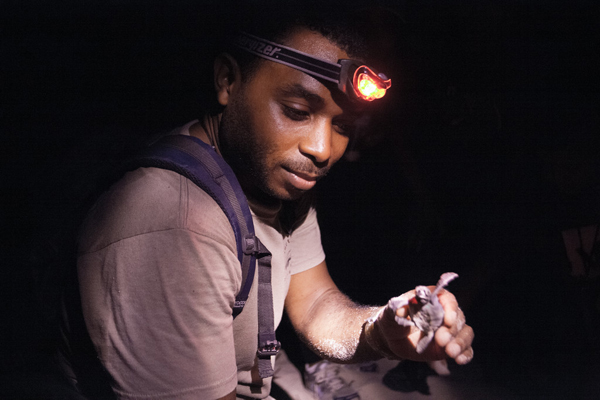
A Brief but Perilous Journey
First, a bit about sea turtles and their nesting habits. There are seven species of sea turtles worldwide, but the Conservancy’s project on St. Croix focuses on green and hawksbill turtles.
Like other sea turtles, these two species spend their life almost entirely at sea, even though many of their movements remain a mystery.
Their nesting habits, though, are well known. Sea turtles return to the beach where they were born to nest. They labor onto the sand, dig a nest, lay their ping pong ball-sized eggs, bury them and return to the sea.
Sixty days later, the young sea turtles hatch, dig through the sand and begin their sea odyssey. They likely won’t return to the beach until they can lay their own eggs, 15 to 30 years later.
Under the best of conditions, life is tough for a young sea turtle. The trip across the beach is filled with dangers, from ants to crabs to sea birds.
They reach the oceans, and then things get really dicey: fish feed voraciously on them.
“Any predatory animal bigger than a turtle eats turtles,” says Lewis. “They run the gauntlet as soon as they hatch.”
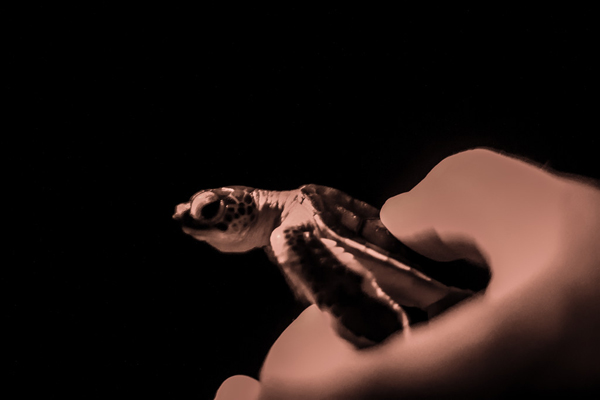
To add to the difficulty, sea turtles no longer only face these usual threats: They have been poached for their meat, eggs and shells. They get tangled in nets. They face pollution and climate change.
And they face new threats on the beach. Could protecting nesting beaches and addressing threats there improve overall sea turtle populations?
One nesting beach on St. Croix, Jack and Isaacs Bay, provides hopeful answers. The Conservancy has made a long-term investment in protection and research, and it’s paying off.
That’s where we’re headed now.
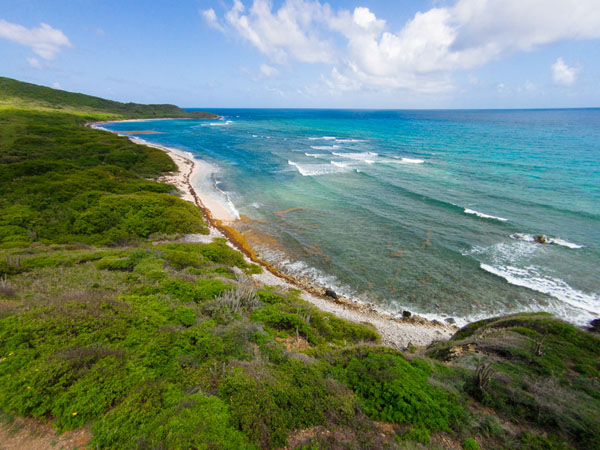
Bringing Back the Turtles
In the early 1990s, it was clear that sea turtles were disappearing on St. Croix. But why?
In 1994, the Conservancy conducted a survey of beaches that looked promising for habitat. The best of the lot, Jack and Isaacs Bay, had only 14 nesting green and hawksbill sea turtles.
The habitat looked right. It could clearly support more turtles. Clearly.
“The Conservancy immediately set about identifying the threats,” says Lewis. “In this case, it became pretty apparent. It was non-native mongoose, and human poachers.”
A mongoose will follow an adult turtle and then dig up the eggs, devouring an entire hatch at once. By setting traps around the beach prior to the nesting season, Conservancy staff found they could remove the mongoose threat. (Read more about the devastating impacts non-native mongoose have on island fauna, and conservationists are addressing this invasive threat, in an upcoming Cool Green Science blog).
For human poachers, it became apparent that there just needed to be enforcement – someone on the beaches to deter illegal harvesting.
Conservancy staff also recognized that they needed more data – a lot more data – to effectively conserve the turtles.
Having researchers on the beach could deter poachers while providing valuable research and monitoring.
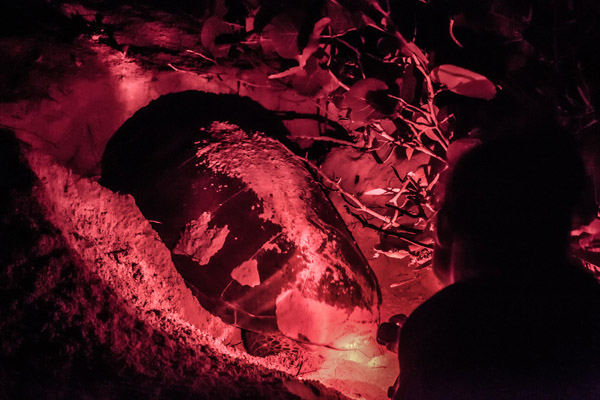
The Conservancy purchased Jack and Isaacs Bay in 1999 and established a turtle research program, with three volunteer researchers living at the Little Princess Preserve and conducting turtle research five nights a week.
“The poaching is non-existent. We’ve addressed the mongoose problem,” says Lewis. “And the turtles have responded.”
This year, 250 green and hawksbill turtles have nested on Jack and Isaacs Bay. But there is still much to learn about these animals.
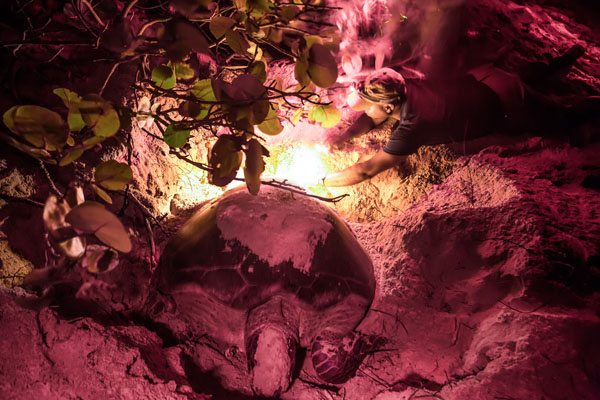
A Night on the Beach
We switch on our red head lamps (turtles are highly sensitive to white lights; it can even throw off their entire nesting process) and head to the beach, where we immediately meet up with one of the volunteers.
They’re out here on the beach from 7 p.m. to 3 a.m., amongst the turtles.
Almost as soon as we set foot on the beach, Lewis points. As my eyes adjust, I make out a dark form digging in the sand.
A turtle digging a nest.
Farther up the beach, another lumbers out of the water.
In water, sea turtles are the very definition of grace; on land, they struggle and lumber. Their flippers appear ill suited for digging, but they shovel out a couple of meters of sand for their nest.
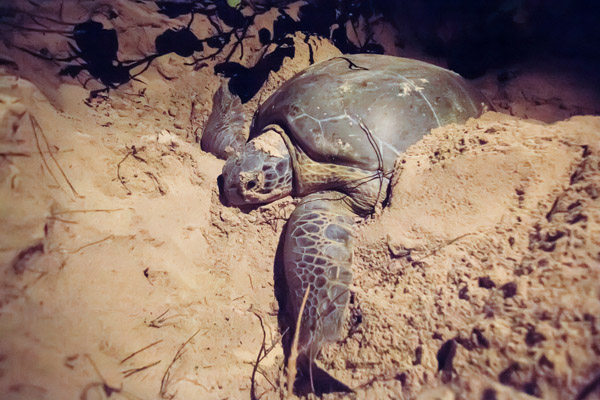
We watch from a short distance away, and the turtle doesn’t notice us. But something about this spot of beach isn’t right, and so the turtle heads back into the water.
For volunteers, each turtle spotted is a bit of a victory – more evidence of conservation success – but also a bit of work. Each turtle must be fitted with a tag, punched harmlessly into its shell. Some will be fitted with satellite telemetry.
Many turtles are already tagged, so they need to be documented. All are measured across the shell. Their general health is recorded. Their nest location is marked and watched. After the babies hatch, they nest will be excavated to determine the rate of hatching success.
Each volunteer also has her own individual research project, including how turtles are utilizing different bays and nesting patterns of the turtles.
“It provides us with an incredible amount of data on these animals,” says Lewis. “It will help us continue to improve our conservation program.”
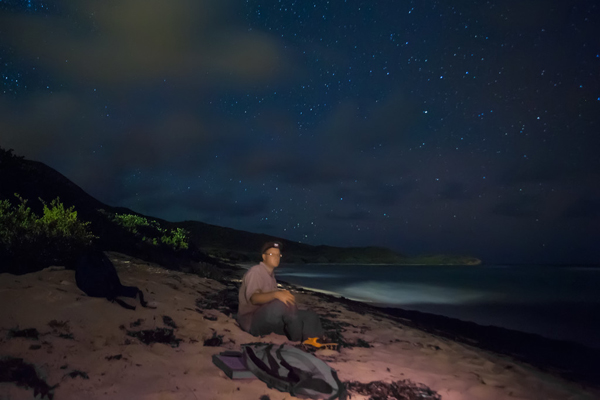
In a Turtle Trance
As the evening wears on, the dark beach seems to sparkle with turtle activity. We sit by another digging a nest, enjoying the sounds of waves breaking and the sight of bioluminescence on the bay.
The shadowy forms of other turtles appear as they make their way out of the water. The volunteer radios crackle as they report back and forth what’s happening. A nest of hatchlings has left for the sea. A hawksbill turtle has nested in the forest. More turtles are coming ashore.
Sitting there, it’s easy to revel in the spectacular conservation success. And Lewis beaming, but he also reminds me of the reality of sea turtle conservation – and perhaps of successful conservation everywhere.
“We are not done here,” says Lewis. “Far from it. If we stopped this program now, we could lose everything we accomplished here on Jack and Isaacs Bay. Mongoose would swarm back if we stopped trapping them. Poaching could resume.”
“Conservation is often not a short-term project,” he says. “We still have a lot to learn. We still think we can accomplish more. As we get more data, and conduct more research, we’ll undoubtedly better be able to protect sea turtles as Jack and Isaacs – and across St. Croix.”
The Conservancy is already partnering extensively with local organizations, businesses and the U.S. Fish and Wildlife Service, the agency that manages another beach important to leatherback turtles.
Lewis is investigating the possibility of paid volunteer trips – where conservationists pay a fee to join turtle research for a week, an incredible nature experience. That would help gather more data, and also provide a funding stream for this program to continue.
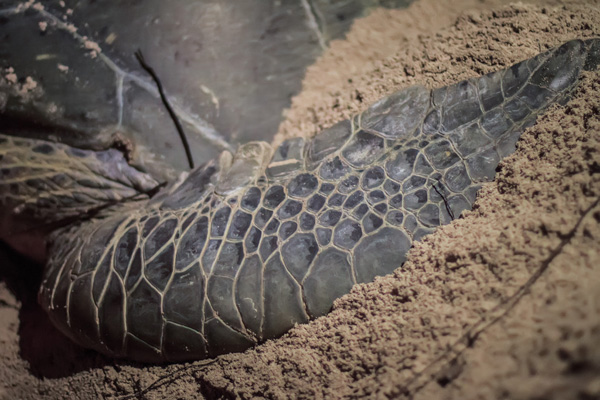
In the meantime, there’s this turtle in front of us. Her digging slows. Lewis taps me on the back, a smile across his face.
“She’s getting ready to lay eggs,” he whispers.
When the turtle lays eggs, it enters into a kind of a trance – it’s oblivious to what is going on around it. And so we gather close, as she strains and pushes. The round, leathery eggs fall into the sand.
My face is now down there with her, as the eggs drop. Minutes later, I realize I’m in my own turtle trance, grateful for the opportunity to be so close to this beautiful creature.
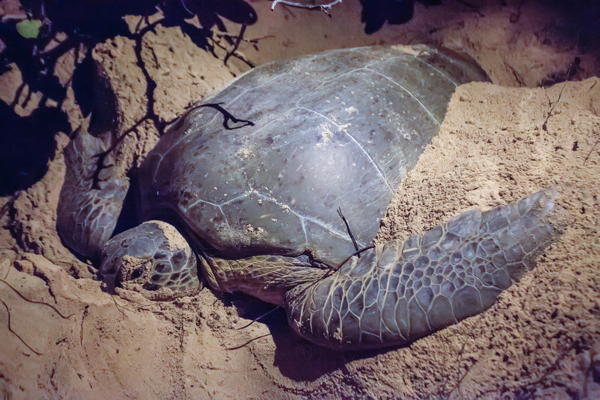
Lewis again taps my shoulder. “Shall we go look at some other turtles, maybe look for some hatchlings?” he asks.
I nod my head as I pull myself up off the sand. I know that sea turtles face many challenges, and the work here is not done. But as this turtle kicks sand on me – covering her nest – it’s hard not to feel hope for the sea turtles of St. Croix.
“Every year we learn more about turtles, and every year we see more signs of their continuing recovery,” says Lewis. “The combination of land protection, addressing threats and research has combined to create what you see here. Twenty years ago, you wouldn’t have seen this many turtles in an entire season. There are still threats, but we have had some very promising results.”
And with that, he is bounding down the beach, towards the next nesting turtle.
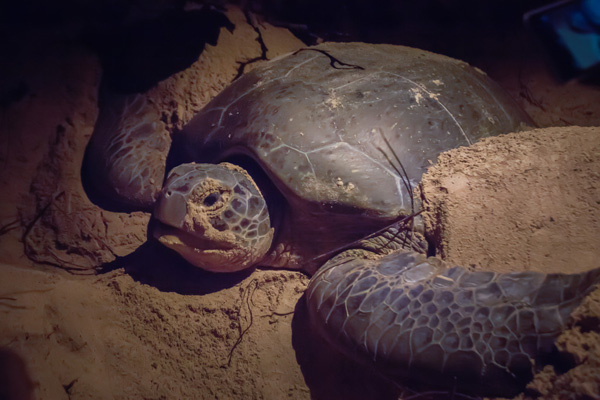



When do the female turtles come to the land to lay their eggs?
The most amazing happened Nov 11, 2015 on the Davis Bay beach Marriott,Carambola resort.
Around 2 pm a nest of baby turtles erupted from the sand! Right next to our lounge chairs! We watched as all 100 or more baby turtles made it safely to the ocean. It was incredible to witness!
Is it odd they hatched during the day? We were wondering if there is less of the Mongoose threat during the day?
Hope they have a chance for survival..
We have a wish to visit St.Croix in our quest for a retirement destination and want to conjoin it with the (Turtle nesting season) can you advise us of the most favorable time during their three month effort. Thank you, Judith K long
I went with the Nature Conservancy’s land steward on a beach walk this past summer at Jack’s Bay. To our amazement we found a leatherback hatchling on the rack line. The land steward said that was the first evidence of leatherbacks nesting at that beach. He had suspected it but that day we found proof, the little hatchling stranded but alive and well. I hope like Kemit, that they do develop a citizen scientist type opportunity for people like me to help out the professionals to help sustain the conservation impact that the island is experiencing.
Always wonderful to hear about such conservation successes. The time frame for most successful conservation projects as mentioned here is definitely long-term.
How can I get involved with the St Croix turtle project, on the ground, rather than just sending in a check?
For Kay Porter: We’re you able to assist in any way? Or were tourists considered to be somewhat of a nuisance?
I visited Costa Rica just two weeks ago and they have beaches where turtles are returning to lay their eggs and the local people in one area patrol the beach stopping boats from coming in and controlling the number of people they let come to watch the turtles. They also chase the birds and animals away that try to steal the eggs. The community takes turns patroling during the turtle’s season.
Some of the truly most valuable work being done on Earth.
turtles are very cool
I love Turtles
Keep up the great work! I love to read about sea turtles and am glad to hear that progress is being made!
Thank you for great coverage of your sea turtle adventures and the incredible conservation work happening here on St. Croix. Come back and visit again soon. http://www.gotostcroix.com